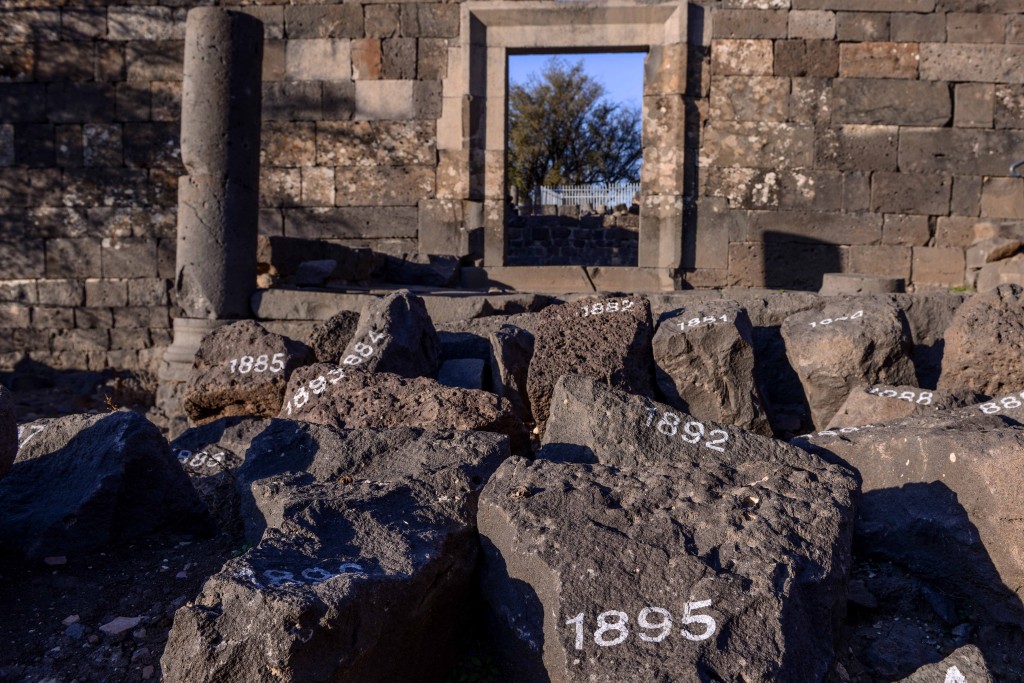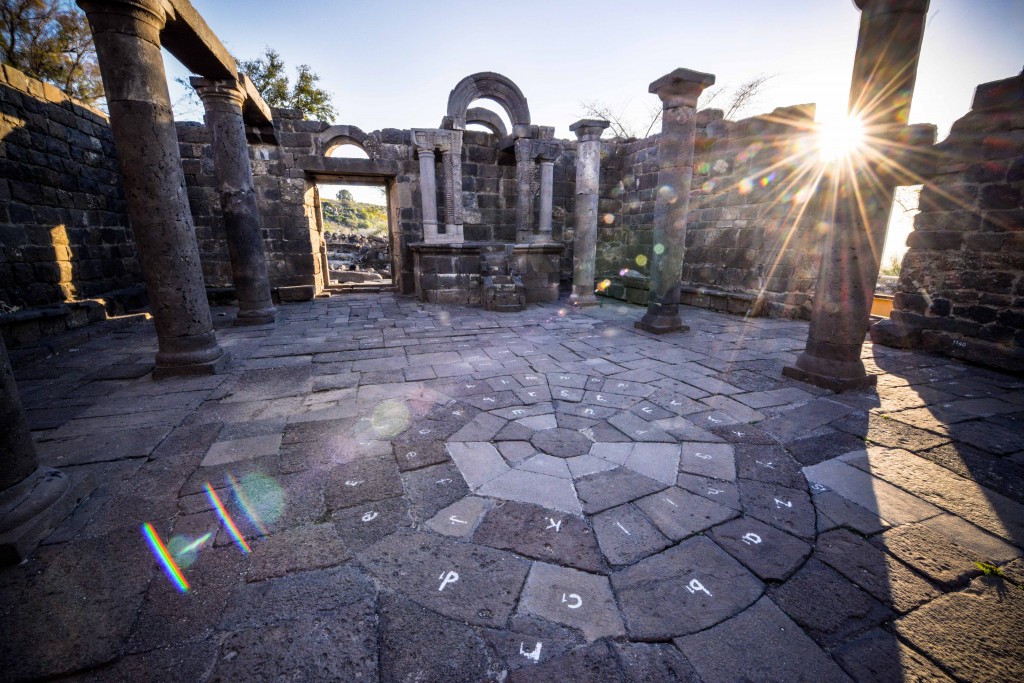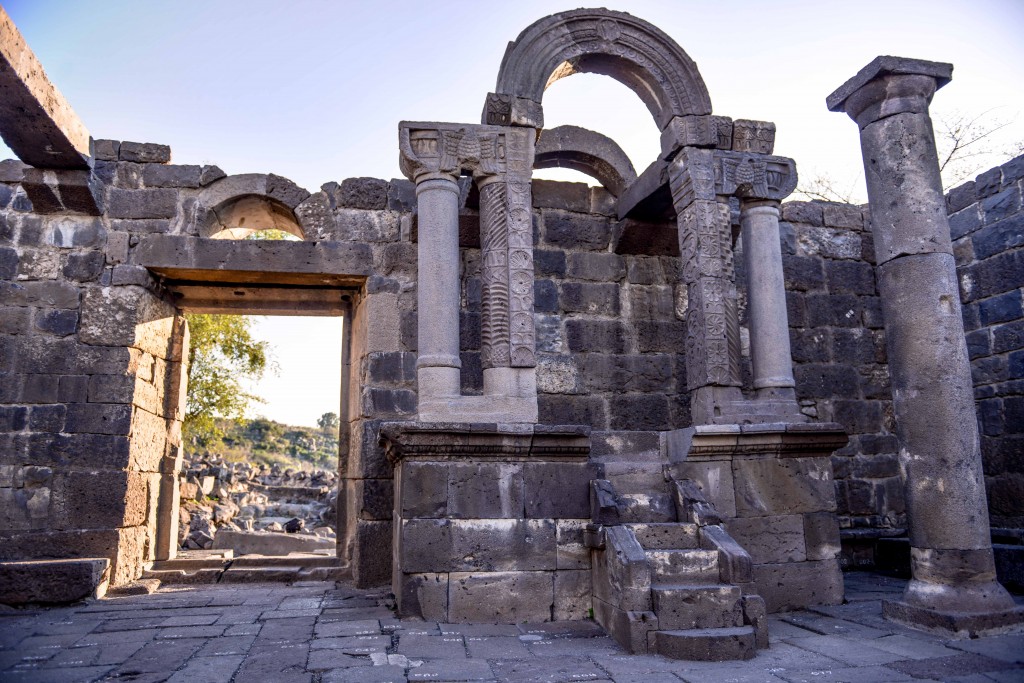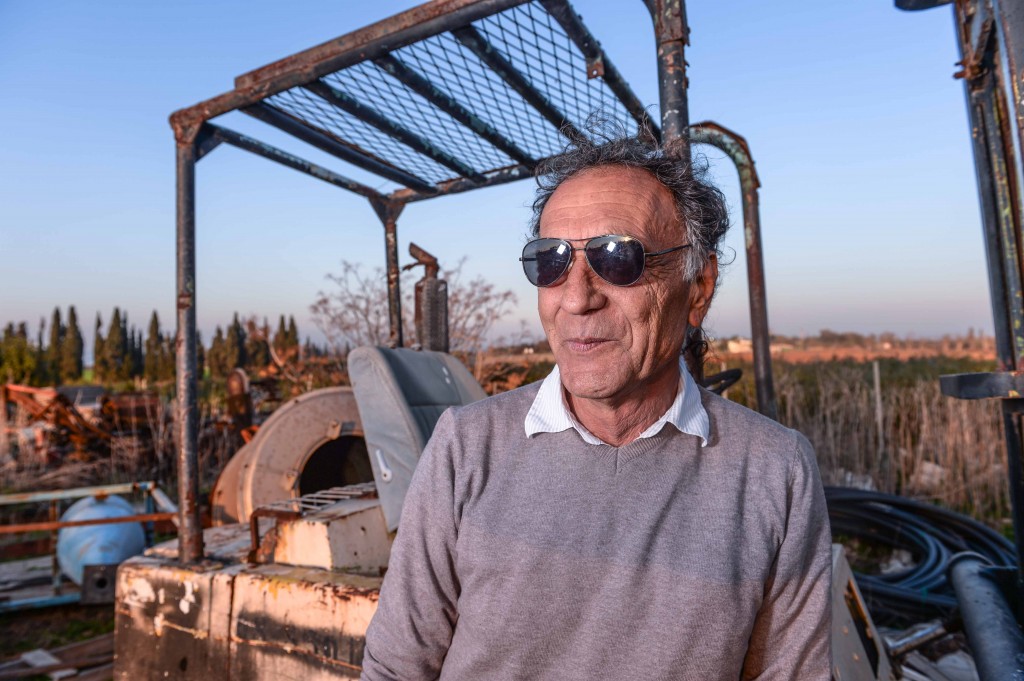So who does this land belong to anyway?
The Palestinians claim that this land "belongs" to them and that Israelis are the invaders, who should give it back to its "rightful owners", the Palestinians. Take a look at the following condensed history timeline (also click "Next" below for a crash course in Middle East history), and you will see that nothing could be farther from the truth. There has been a continuous Jewish presence in what is today Israel since the 13th century BC, while the first Arabs only arrived in the area with the Muslim conquests of the 7th century AD...
The Hebrews arrived in the area known today as Israel ca. 1250 BC, and the first Kingdom was established under Saul in 1020 BC. The Kingdom of Israel continued under the rule of David and Solomon (during which time the first temple was built in Jerusalem) until the land was conquered by Assyria in 722 BC, and subsequently by various other conquering armies.
When the Babylonians conquered the land in 586 BC, the temple was destroyed.
When the Persians defeated the Babylonians in 538 BC, beginning a period of Persian rule, the second temple was built in Jerusalem.
There were several exchanges of power in the centuries to follow, including of course the Romans, who took control in 63 BC.
The second temple was destroyed in 70 AD by the Romans, and was never rebuilt. All that remains of it is the "Wailing Wall", or "Western Wall", at the base of the Temple Mount. This is the holiest site of the Jews.
It is of interest to note that it was the Romans who first coined the name "Palestine", based upon the name of the "Philistines", an Aegean people who had arrived in the area shortly after the Hebrews arrived from exile in Egypt. This was in order to attempt to dissociate the land from its Jewish history. It is based upon this that the Arabs now living in the area refer to themselves as "Palestinians", even though there were no Arabs here at the time the name Palestine was first used.
The Roman Byzantine period continued until 638 AD, when the Muslim conquests brought the first Arabs into the area. It is only at the end of the seventh century that Jerusalem was declared by the Arabs to be a holy site for Islam (Jerusalem is not mentioned a single time in the Koran).
In 691 AD, during the reign of the Omayyad dynasty, the Dome of the Rock was built and inaugurated by Abd Al-Malik ibn Al Marwan.
The Omayyad dynasty did not last long, and was succeeded by the Abbasids, who transferred their capital from Damascus to Baghdad.
After 460 years of Muslim rule, Jerusalem fell to the crusaders, who declared the city the capital of the Kingdom of Jerusalem.
The crusaders were succeeded by Saladin, and then the Mamelukes, until the Ottoman Turks defeated the Mameluke forces in 1517 AD and began a 400 year Turkish domination of the Near East.
In 1917, near the end of World War I, the Turks surrendered to British forces, beginning the 31 year period of the British mandate over Palestine.
In 1947, the United Nations voted for a plan to partition Palestine into an Arab state and a Jewish state, Israel.
In May, 1948, the State of Israel was declared within the boundaries defined by the U.N. resolution. The Arabs refused to accept this, and less than 24 hours after the Declaration of Independence, five Arab armies attacked the new Jewish State. The rest is, as they say, history...
It is noteworthy that throughout the history of Israel/Jerusalem/Palestine, while Jewish political fortunes since the time of the first Jewish commonwealth have fluctuated, Jews always regarded Jerusalem as their capital. In the Islamic tradition, Jerusalem served as a spiritual center, but has NEVER served as a political center. Even after the Muslim conquests of the 7th century AD, the administrative center of Palestine was Ramle, not Jerusalem. Jerusalem has NEVER served as an Islamic capital.
Moreover, under Israeli rule, everyone from any religion is allowed free access to their holy sites in Jerusalem. In stark contrast to this, Jordanian rule over East Jerusalem (including the Old City and all the holy sites) between 1948 and 1967 led to the complete denial of access to Jews (from anywhere in the world) and Christians (from Israel) to the holy sites in Jerusalem. Indeed, after the fall of the Jewish Quarter of Jerusalem in 1948, its Jewish inhabitants were expelled, and fifty-eight of its synagogues were either destroyed or desecrated by being used as stables by the Palestinian Arabs.
Click "Next" for a crash course in Middle East history
The Hebrews arrived in the area known today as Israel ca. 1250 BC, and the first Kingdom was established under Saul in 1020 BC. The Kingdom of Israel continued under the rule of David and Solomon (during which time the first temple was built in Jerusalem) until the land was conquered by Assyria in 722 BC, and subsequently by various other conquering armies.
When the Babylonians conquered the land in 586 BC, the temple was destroyed.
When the Persians defeated the Babylonians in 538 BC, beginning a period of Persian rule, the second temple was built in Jerusalem.
There were several exchanges of power in the centuries to follow, including of course the Romans, who took control in 63 BC.
The second temple was destroyed in 70 AD by the Romans, and was never rebuilt. All that remains of it is the "Wailing Wall", or "Western Wall", at the base of the Temple Mount. This is the holiest site of the Jews.
It is of interest to note that it was the Romans who first coined the name "Palestine", based upon the name of the "Philistines", an Aegean people who had arrived in the area shortly after the Hebrews arrived from exile in Egypt. This was in order to attempt to dissociate the land from its Jewish history. It is based upon this that the Arabs now living in the area refer to themselves as "Palestinians", even though there were no Arabs here at the time the name Palestine was first used.
The Roman Byzantine period continued until 638 AD, when the Muslim conquests brought the first Arabs into the area. It is only at the end of the seventh century that Jerusalem was declared by the Arabs to be a holy site for Islam (Jerusalem is not mentioned a single time in the Koran).
In 691 AD, during the reign of the Omayyad dynasty, the Dome of the Rock was built and inaugurated by Abd Al-Malik ibn Al Marwan.
The Omayyad dynasty did not last long, and was succeeded by the Abbasids, who transferred their capital from Damascus to Baghdad.
After 460 years of Muslim rule, Jerusalem fell to the crusaders, who declared the city the capital of the Kingdom of Jerusalem.
The crusaders were succeeded by Saladin, and then the Mamelukes, until the Ottoman Turks defeated the Mameluke forces in 1517 AD and began a 400 year Turkish domination of the Near East.
In 1917, near the end of World War I, the Turks surrendered to British forces, beginning the 31 year period of the British mandate over Palestine.
In 1947, the United Nations voted for a plan to partition Palestine into an Arab state and a Jewish state, Israel.
In May, 1948, the State of Israel was declared within the boundaries defined by the U.N. resolution. The Arabs refused to accept this, and less than 24 hours after the Declaration of Independence, five Arab armies attacked the new Jewish State. The rest is, as they say, history...
It is noteworthy that throughout the history of Israel/Jerusalem/Palestine, while Jewish political fortunes since the time of the first Jewish commonwealth have fluctuated, Jews always regarded Jerusalem as their capital. In the Islamic tradition, Jerusalem served as a spiritual center, but has NEVER served as a political center. Even after the Muslim conquests of the 7th century AD, the administrative center of Palestine was Ramle, not Jerusalem. Jerusalem has NEVER served as an Islamic capital.
Moreover, under Israeli rule, everyone from any religion is allowed free access to their holy sites in Jerusalem. In stark contrast to this, Jordanian rule over East Jerusalem (including the Old City and all the holy sites) between 1948 and 1967 led to the complete denial of access to Jews (from anywhere in the world) and Christians (from Israel) to the holy sites in Jerusalem. Indeed, after the fall of the Jewish Quarter of Jerusalem in 1948, its Jewish inhabitants were expelled, and fifty-eight of its synagogues were either destroyed or desecrated by being used as stables by the Palestinian Arabs.
Crash course in Middle East history
Nationhood and Jerusalem
Israel became a nation in 1312 BCE -- 2,000 years before the rise of Islam.Arab refugees in Israel began identifying themselves as part of a Palestinian people in 1967, two decades after the establishment of the modern State of Israel.Since the Jewish conquest in 1272 BCE, the Jews have had dominion over the land for 1,000 years, with a continuous presence in the land for the past 3,300 years.The only Arab dominion since the conquest in 635 CE lasted no more than 22 years.
For over 3,000 years, Jerusalem has always been the Jewish capital.Jerusalem has never once been the capital of any Arab or Muslim entity. In the 20 years that Jordan occupied Jerusalem (1948-1967), they never sought to make it their capital, nor did Palestinians demand it as theirs.
Jerusalem is mentioned over 700 times in the Jewish Bible.Jerusalem is not mentioned once in the Koran.
King David founded the city of Jerusalem 3,000 years ago.Mohammed never came to Jerusalem.
Jews pray facing Jerusalem, wherever they are in the world.Moslems at the mosque in Jerusalem pray with their backs toward Jerusalem.
Arab and Jewish Refugees
In 1948, approximately 630,000 Arab refugees were encouraged to leave Israel by Arab leaders promising to purge the land of Jews. Sixty-eight percent left without ever seeing an Israeli soldier.
In that same era, approximately 850,000 Jewish refugees were forced to flee from Arab lands due to brutality, persecution and pogroms (click "Next" below to read details on the treatment of Jews in several Arab countries).
Jewish refugees were completely absorbed into Israel, a country no larger than the state of New Jersey.
Arab refugees were intentionally not absorbed or integrated into the Arab lands to which they fled, despite the vast Arab territory. Out of 100 million worldwide refugees since World War Two, these Arabs are the only refugee group in the world that has not been integrated into their own peoples' lands.
The Arab - Israeli Conflict
The Arab world includes 22 separate nations.There is only one Jewish nation; collectively, the Arabs have 50 times the population of Israel, and 800 times the territory! And yet, Israel is the one who must always exchange "land for peace".
The Arab nations initiated five wars against Israel, and lost.Israel defended itself each time and won.
The P.L.O. Charter still calls for the destruction of the State of Israel.Israel has given the Palestinians most of the West Bank land, autonomy under the Palestinian Authority, and has supplied them with weapons.
Under Jordanian rule, Jewish holy sites were desecrated: all synagogues in the Old City were torched, and tombstones from the ancient Mount of Olives cemetery was used to pave roads and build latrines. Jews were also denied access to places of worship at the Western Wall, Tomb of Rachel, Tomb of Joseph, and cave of the Patriarchs. The Palestinians have recently destroyed Joseph's Tomb and a number of synagogues under their "protection".Under Israeli rule, all Moslem and Christian holy sites have been preserved and made accessible to people of all faiths.
The U.N. Record on Israel and the Arabs
Of the 175 Security Council resolutions passed before 1990, 97 were directed against Israel.
Of the 690 General Assembly resolutions voted on before 1990, 429 were directed against Israel.
The U.N. was silent while 58 Jerusalem synagogues were destroyed by the Jordanians.
The U.N. was silent while the Jordanians systematically desecrated the ancient Jewish cemetary on the Mount of Olives.
The U.N.was silent while the Jordanians enforced an apartheid-like policy of preventing Jews from visiting the Temple Mount and the Western Wall, the holiest site in Judaism.
The U.N. has been totally silent on the Palestinian history of suicide bombings, lynchings, terrorist attacks, bus hijackings, cafe bombings, etc.
Treatment of Jews in Arab Countries
(source: Middle East Digest - November/December 1999)
Egypt:
Approximately 75,000 Jews lived in Egypt in 1948, a community whose origins date back to the Babylonian captivity some 2700 years prior. In the preceding decade, Muslim elements, believing that Hitler would be successful in completing the 'Final Solution' in Europe, carried out almost continuous pogroms against Jewish communities, killing and injuring thousands. The Egyptian Company Law of July 1947 introduced prohibitive quotas against employing Jews, precluded them from most areas of employment, and confiscated many Jewish-owned businesses, properties and other assets. Then, in the days after the passage of the Partition Plan, Muslims in Cairo and Alexandria went on a rampage, murdering, looting houses and burning synagogues. In one seven-day period in 1948, an eyewitness counted 150 Jewish bodies littering the streets.
During the War of Independence, Egyptian Jews were barred from travelling abroad. In August 1949, Egypt lifted the ban and 20,000 Jews fled the country, many going to Israel. Conditions for Jews improved somewhat under General Naguib, but when General Abdul Nasser rose to power in Egypt, he ordered mass arrests of Jews and confiscated huge quantities of Jewish property, personal and commercial. Nasser issued deportation orders to thousands of Jews, concurrently confiscating all their property and assets. Most of the deportees were limited to one suitcase apiece. In 1964, Nasser boldly declared, in an interview with a German publication, that Egypt still adhered to the Nazi cause: 'Our sympathy,' he said, 'was with the Germans.' With the outbreak of the 1967 Six-Day War, Jews were arrested en masse and sent to concentration camps, where they were tortured, denied water for days and forced to chant anti-Israel slogans. By 1970, Egypt's Jewish population numbered in the mere hundreds.
Algeria:
Like other Muslim nations, Algeria possesses a long history of anti-Semitism, legal and popular. The colonization of Algeria by the French in 1830, though, liberated the 2500-year-old Jewish community from much of the humiliation and persecution it had sustained under Islamic rule. But the rise of the Nazi Party in Germany augured a reversion to anti-Semitic activities. In 1934, twenty-five Jews were massacred in Constantine. During the subsequent trial by French authorities, evidence revealed the attack was organized by the city's leading Muslim authorities. When the French Vichy government took power in 1940, it immediately stripped Jews of their French citizenry, banned them from schools and declared them 'pariahs.' Only the Allied landing soon thereafter saved the Jews from mass deportation to European death camps. With the fall of the Vichy regime, more than 148,000 Jews enjoyed the full benefits and affluence of French society. A civil war erupted in Algeria, and as it intensified, thousands of Jews fled the country, mostly for France.
Algeria achieved independence in 1962, by which time more than 75,000 Jews had departed. State-sanctioned persecution began the following year with the passage of the 1963 Nationality Code, limiting citizenship to those residents whose father and paternal grandfather were Muslim. The new state confiscated or destroyed Jewish private, commercial and communal property and ordered most of the nation's synagogues converted into mosques. Following a flood of anti-Semitic violence in 1965, the majority of the remaining Jewish community of 65,000 departed. Today, the once vigorous Algerian Jewish community numbers a paltry 300.
Libya:
Today, no Jews are known to live in the north African nation of Libya. Like Egypt and Algeria, massive pogroms decimated the once-thriving Jewish communities in the 1940s. From 1941-1942, great waves of persecution washed over Libya. Jewish property in Benghazi was pillaged and 2,600 were sent into the desert to a forced labor camp, where 500 perished. On November 5, 1945, a horrendous bloodbath ensued in the Libyan capital of Tripoli. According to New York Times reporter Clifton Daniels: 'Babies were beaten to death with iron bars. Old men were hacked to pieces where they fell. Expectant mothers were disembowelled. Whole families were burned alive in their houses.' Several hundred Jews died in the attack.
After the approval of the Partition Plan, another 130 Jews were murdered in anti-Semitic rioting. The following year saw another Tripoli-like massacre. In 1948, Libya's Jewish population was 38,000; by 1951 only 8,000 remained. After the Six-Day War, another pogrom erupted, driving all but 400 from the country. On July 21, 1967 Libyan strongman Colonel Qadhafi nationalized all Jewish property, and soon thereafter, all remaining Jews left the country.
Syria:
The Syrian Jewish community in 1948 dated to the First Century destruction of Jerusalem, approximately 1900 years earlier. Under Islamic rule, Jews were routinely subject to cruel and inhumane treatment, including forced conversions, routine pogroms and severe commercial and personal restrictions. By early 1947, only 13,000 Jews lived in Syria; 20,000 had fled throughout the course of the previous decade, as Nazi zeal permeated the region and made their lives especially difficult. Immediately after Syria gained independence from France in 1945, vitriolic anti-Semitic propaganda was broadcast on television and radio, inciting the Arab masses to violence. In December 1947, one month after the Partition Plan's acceptance, a pogrom erupted in the Syrian town of Aleppo, torching numerous Jewish properties, including synagogues, schools, orphanages and businesses. Eyewitnesses to the violence noted Syrian firemen and police dispatched to the scene actively participated in the rioting.
A flurry of anti-Semitic legislation passed in 1948 restricted, among other things, Jewish travel outside of government-approved ghettos, selling private property, acquiring land or changing their place of residence. A decree in 1949 went a step further, seizing all Jewish bank accounts. Under threats of execution, long prison sentences and torture, 10,000 Jews were able to depart between 1948 and 1962. A report published in 1981 indicated Syrian Jews were subject to "the Mukhabarat, the [Syrian] secret police, [who] conduct a reign of terror and intimidation, including searches without warrant, detention without trial, torture and summary execution." Due mainly to US influence in the context of the Madrid peace process, all but about 800 of the Jewish community have fled, most settling in the United States. Syria has confiscated all Jewish property aside from those who remain.
Yemen:
The Yemenite Jewish community existed in what historian S.D. Goitein described as the "worst aspect" of the Arab mistreatment of the Jew. Jewish life in Yemen, up to the time of Israel's modern evacuation of the community, contained the harshest elements imaginable under dhimmitude status. Jews could not testify in court, and were regularly murdered, limited to employment in the most demeaning of positions and forced to relinquish their property on demand, to name a very few deprivations. An "age-old" custom of stoning Jews, permissible by Muslim law, was still regularly practiced up to the time the Jews fled Yemen. Conditions for the community were exacerbated by Israel's victory over Arab armies in 1948, making the swift extraction of the community a matter of rescue or extinction. Arab mobs swarmed through Tsan'a and other towns, burning, murdering, raping and looting in the city's Jewish quarters. The region's imam - or religious authority - permitted the Jewish community to leave Yemen, provided they forfeit all property to the state. Israel launched Operation Magic Carpet in 1949, and over the course of one year, successfully airlifted some 50,000 Yemenite Jews - almost the entire ancient community - to Israel.
Iraq:
The 135,000 strong Iraqi Jewish community in 1948 traced their origins to the pre-exilic Jewish community of Babylon, 2700 years previous. Anti-Semitic legislation in 1948, declared "Zionism" - a crime accorded to Jews automatically - an offence punishable by a seven-year jail term. Additional legislation barred Jews from government, medicine and education, denied merchants import licenses and closed Jewish banks. The Jewish community faced economic ruin. During Israel's War of Independence, immigration to Israel was declared a capital offense while public Law No. 1, passed in 1950, stripped Jews of their Iraqi nationality. In 1950, Israel launched Operation Ali Baba to extricate the destitute remnant. Iraq, intrigued at the prospect of inheriting large quantities of abandoned Jewish property, allowed the Jews to leave, reassuring emigrants they would receive fair compensation for property and other assets they were forced to abandon. The airlift spirited 123,000 Jews out of the country, with 110,000 choosing to remain in Israel. Despite it's promise, the Iraqi government announced on March 10, 1951 - the day after the deadline for exit registration - that emigrant's property, businesses and bank accounts were forfeit. That same year, Law No. 5 was expanded to include all Jewish holdings in Iraqi banks. By itself, this extension looted $200 million in Jewish assets. By January 1952, as Iraq again closed the doors to Jewish emigration, only 6,000 remained. All remaining Jewish communal property was confiscated in 1958. Today, only 200 Jews remain in Iraq, forced to reside in a Baghdad ghetto.
Approximately 75,000 Jews lived in Egypt in 1948, a community whose origins date back to the Babylonian captivity some 2700 years prior. In the preceding decade, Muslim elements, believing that Hitler would be successful in completing the 'Final Solution' in Europe, carried out almost continuous pogroms against Jewish communities, killing and injuring thousands. The Egyptian Company Law of July 1947 introduced prohibitive quotas against employing Jews, precluded them from most areas of employment, and confiscated many Jewish-owned businesses, properties and other assets. Then, in the days after the passage of the Partition Plan, Muslims in Cairo and Alexandria went on a rampage, murdering, looting houses and burning synagogues. In one seven-day period in 1948, an eyewitness counted 150 Jewish bodies littering the streets.
During the War of Independence, Egyptian Jews were barred from travelling abroad. In August 1949, Egypt lifted the ban and 20,000 Jews fled the country, many going to Israel. Conditions for Jews improved somewhat under General Naguib, but when General Abdul Nasser rose to power in Egypt, he ordered mass arrests of Jews and confiscated huge quantities of Jewish property, personal and commercial. Nasser issued deportation orders to thousands of Jews, concurrently confiscating all their property and assets. Most of the deportees were limited to one suitcase apiece. In 1964, Nasser boldly declared, in an interview with a German publication, that Egypt still adhered to the Nazi cause: 'Our sympathy,' he said, 'was with the Germans.' With the outbreak of the 1967 Six-Day War, Jews were arrested en masse and sent to concentration camps, where they were tortured, denied water for days and forced to chant anti-Israel slogans. By 1970, Egypt's Jewish population numbered in the mere hundreds.
Algeria:
Like other Muslim nations, Algeria possesses a long history of anti-Semitism, legal and popular. The colonization of Algeria by the French in 1830, though, liberated the 2500-year-old Jewish community from much of the humiliation and persecution it had sustained under Islamic rule. But the rise of the Nazi Party in Germany augured a reversion to anti-Semitic activities. In 1934, twenty-five Jews were massacred in Constantine. During the subsequent trial by French authorities, evidence revealed the attack was organized by the city's leading Muslim authorities. When the French Vichy government took power in 1940, it immediately stripped Jews of their French citizenry, banned them from schools and declared them 'pariahs.' Only the Allied landing soon thereafter saved the Jews from mass deportation to European death camps. With the fall of the Vichy regime, more than 148,000 Jews enjoyed the full benefits and affluence of French society. A civil war erupted in Algeria, and as it intensified, thousands of Jews fled the country, mostly for France.
Algeria achieved independence in 1962, by which time more than 75,000 Jews had departed. State-sanctioned persecution began the following year with the passage of the 1963 Nationality Code, limiting citizenship to those residents whose father and paternal grandfather were Muslim. The new state confiscated or destroyed Jewish private, commercial and communal property and ordered most of the nation's synagogues converted into mosques. Following a flood of anti-Semitic violence in 1965, the majority of the remaining Jewish community of 65,000 departed. Today, the once vigorous Algerian Jewish community numbers a paltry 300.
Libya:
Today, no Jews are known to live in the north African nation of Libya. Like Egypt and Algeria, massive pogroms decimated the once-thriving Jewish communities in the 1940s. From 1941-1942, great waves of persecution washed over Libya. Jewish property in Benghazi was pillaged and 2,600 were sent into the desert to a forced labor camp, where 500 perished. On November 5, 1945, a horrendous bloodbath ensued in the Libyan capital of Tripoli. According to New York Times reporter Clifton Daniels: 'Babies were beaten to death with iron bars. Old men were hacked to pieces where they fell. Expectant mothers were disembowelled. Whole families were burned alive in their houses.' Several hundred Jews died in the attack.
After the approval of the Partition Plan, another 130 Jews were murdered in anti-Semitic rioting. The following year saw another Tripoli-like massacre. In 1948, Libya's Jewish population was 38,000; by 1951 only 8,000 remained. After the Six-Day War, another pogrom erupted, driving all but 400 from the country. On July 21, 1967 Libyan strongman Colonel Qadhafi nationalized all Jewish property, and soon thereafter, all remaining Jews left the country.
Syria:
The Syrian Jewish community in 1948 dated to the First Century destruction of Jerusalem, approximately 1900 years earlier. Under Islamic rule, Jews were routinely subject to cruel and inhumane treatment, including forced conversions, routine pogroms and severe commercial and personal restrictions. By early 1947, only 13,000 Jews lived in Syria; 20,000 had fled throughout the course of the previous decade, as Nazi zeal permeated the region and made their lives especially difficult. Immediately after Syria gained independence from France in 1945, vitriolic anti-Semitic propaganda was broadcast on television and radio, inciting the Arab masses to violence. In December 1947, one month after the Partition Plan's acceptance, a pogrom erupted in the Syrian town of Aleppo, torching numerous Jewish properties, including synagogues, schools, orphanages and businesses. Eyewitnesses to the violence noted Syrian firemen and police dispatched to the scene actively participated in the rioting.
A flurry of anti-Semitic legislation passed in 1948 restricted, among other things, Jewish travel outside of government-approved ghettos, selling private property, acquiring land or changing their place of residence. A decree in 1949 went a step further, seizing all Jewish bank accounts. Under threats of execution, long prison sentences and torture, 10,000 Jews were able to depart between 1948 and 1962. A report published in 1981 indicated Syrian Jews were subject to "the Mukhabarat, the [Syrian] secret police, [who] conduct a reign of terror and intimidation, including searches without warrant, detention without trial, torture and summary execution." Due mainly to US influence in the context of the Madrid peace process, all but about 800 of the Jewish community have fled, most settling in the United States. Syria has confiscated all Jewish property aside from those who remain.
Yemen:
The Yemenite Jewish community existed in what historian S.D. Goitein described as the "worst aspect" of the Arab mistreatment of the Jew. Jewish life in Yemen, up to the time of Israel's modern evacuation of the community, contained the harshest elements imaginable under dhimmitude status. Jews could not testify in court, and were regularly murdered, limited to employment in the most demeaning of positions and forced to relinquish their property on demand, to name a very few deprivations. An "age-old" custom of stoning Jews, permissible by Muslim law, was still regularly practiced up to the time the Jews fled Yemen. Conditions for the community were exacerbated by Israel's victory over Arab armies in 1948, making the swift extraction of the community a matter of rescue or extinction. Arab mobs swarmed through Tsan'a and other towns, burning, murdering, raping and looting in the city's Jewish quarters. The region's imam - or religious authority - permitted the Jewish community to leave Yemen, provided they forfeit all property to the state. Israel launched Operation Magic Carpet in 1949, and over the course of one year, successfully airlifted some 50,000 Yemenite Jews - almost the entire ancient community - to Israel.
Iraq:
The 135,000 strong Iraqi Jewish community in 1948 traced their origins to the pre-exilic Jewish community of Babylon, 2700 years previous. Anti-Semitic legislation in 1948, declared "Zionism" - a crime accorded to Jews automatically - an offence punishable by a seven-year jail term. Additional legislation barred Jews from government, medicine and education, denied merchants import licenses and closed Jewish banks. The Jewish community faced economic ruin. During Israel's War of Independence, immigration to Israel was declared a capital offense while public Law No. 1, passed in 1950, stripped Jews of their Iraqi nationality. In 1950, Israel launched Operation Ali Baba to extricate the destitute remnant. Iraq, intrigued at the prospect of inheriting large quantities of abandoned Jewish property, allowed the Jews to leave, reassuring emigrants they would receive fair compensation for property and other assets they were forced to abandon. The airlift spirited 123,000 Jews out of the country, with 110,000 choosing to remain in Israel. Despite it's promise, the Iraqi government announced on March 10, 1951 - the day after the deadline for exit registration - that emigrant's property, businesses and bank accounts were forfeit. That same year, Law No. 5 was expanded to include all Jewish holdings in Iraqi banks. By itself, this extension looted $200 million in Jewish assets. By January 1952, as Iraq again closed the doors to Jewish emigration, only 6,000 remained. All remaining Jewish communal property was confiscated in 1958. Today, only 200 Jews remain in Iraq, forced to reside in a Baghdad ghetto.









